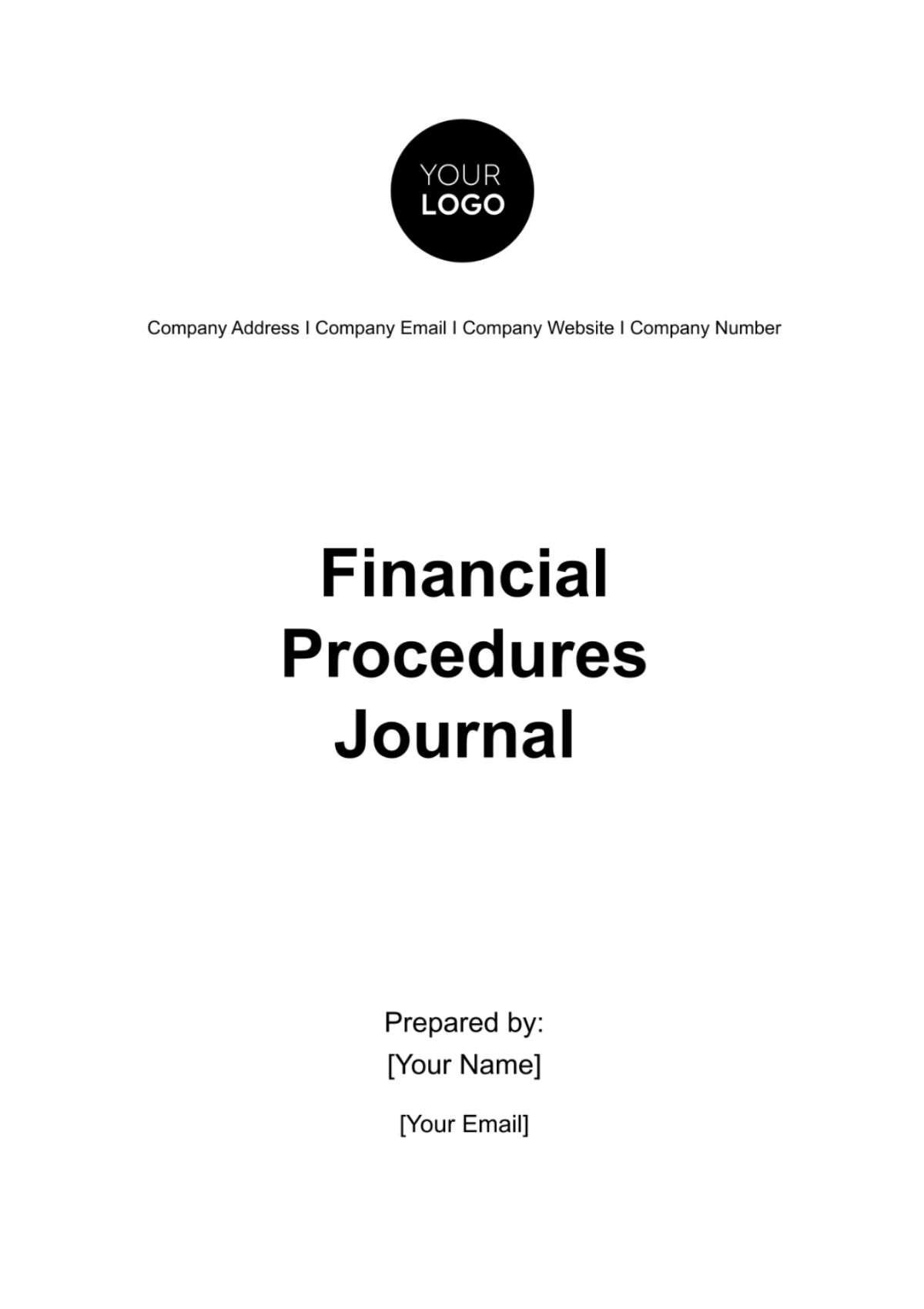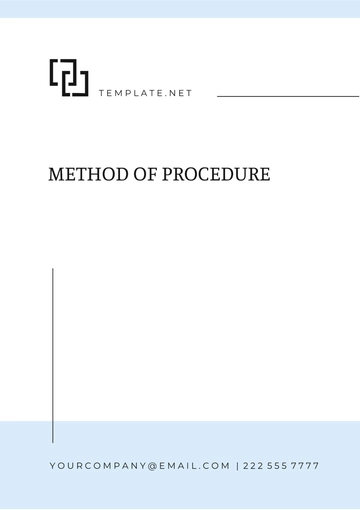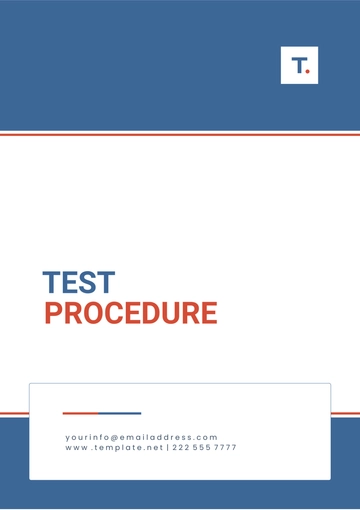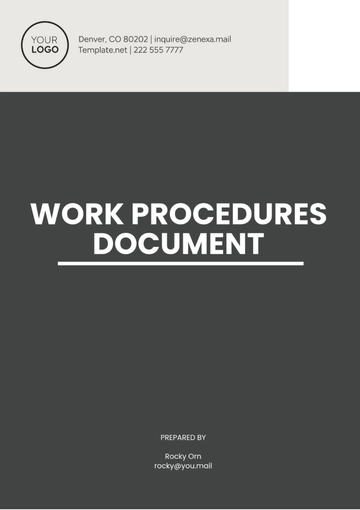Free Financial Procedures Journal

I. Introduction to the Financial Procedures Journal
Purpose and Scope
This Financial Procedures Journal serves as the definitive guide for all financial operations at [Your Company Name]. It is designed to ensure consistency, transparency, and compliance in our financial practices, aligning with our overall strategic objectives. The scope of this journal encompasses all financial transactions and processes, ranging from budgeting and accounting to payroll and risk management.
Overview of [Your Company Name]'s Financial Philosophy
At [Your Company Name], we believe in a financial management philosophy that emphasizes sustainability, integrity, and efficiency. Our financial decisions are guided by a commitment to long-term value creation, ethical practices, and a proactive approach to risk management.
Structure of the Journal
The journal is structured to provide a comprehensive overview of our financial procedures, divided into specific sections for easy navigation. Each section details a particular aspect of financial management, complete with step-by-step processes, responsibilities, and relevant policies.
II. Financial Planning and Budgeting
The annual budget preparation process begins in Q3 of the preceding year. Department heads are required to submit their budget proposals, outlining projected revenues and expenses for the upcoming year. The Finance Department then consolidates these proposals, reviews them for alignment with strategic goals, and prepares a draft budget.
Budget Review and Approval Procedure
The draft budget is reviewed by the Budget Committee, comprising senior management and key stakeholders. After thorough discussion and necessary adjustments, the budget is presented to the Board of Directors for final approval. Once approved, the budget is distributed to all departments for implementation.
Modifications and Amendments to Budgets
Budget modifications may be necessary due to unforeseen circumstances. Any proposed changes exceeding 5% of the total departmental budget must be reviewed and approved by the Finance Department and, if necessary, escalated to the Budget Committee.
Multi-Year Financial Planning
[Your Company Name] also engages in multi-year financial planning to align our long-term strategic goals with financial resources. This plan is reviewed and updated annually to reflect changes in the business environment and company objectives.
III. Expenditure Management
Procurement Policies and Procedures
Our procurement policy mandates competitive bidding for purchases exceeding $10,000. All vendors must undergo a thorough vetting process to ensure compliance with our ethical standards and quality requirements. The Procurement Department is responsible for overseeing all purchasing activities and ensuring adherence to the policy.
Expense Authorization and Reimbursement
Expenses incurred by employees on behalf of [Your Company Name] must be pre-approved by their respective department heads. Reimbursements are processed upon submission of a completed expense report, accompanied by receipts and a detailed explanation of the expenditure.
Contract Management and Vendor Payments
Contracts with vendors and service providers are managed by the Legal and Finance Departments. Payments to vendors are processed only after receiving and verifying invoices. Regular audits are conducted to ensure the accuracy of vendor payments and compliance with contract terms.
Capital Expenditure Planning and Approval
Capital expenditures are subject to a rigorous approval process. Proposals for capital expenditures must include a detailed cost-benefit analysis and alignment with our strategic objectives. These proposals are reviewed by the Capital Expenditure Committee before being submitted to the Board for final approval.
IV. Accounting and Record-Keeping
At [Your Company Name], our accounting practices conform to Generally Accepted Accounting Principles (GAAP). We ensure all financial records accurately reflect our business transactions. Regular training is provided to our accounting staff to keep them abreast of any changes in accounting standards and practices.
Chart of Accounts
Our Chart of Accounts is structured to provide a clear, comprehensive view of our financial position. It includes:
ASSETS | Including current assets (cash, inventory) and fixed assets (property, equipment) |
LIABILITIES | Covering current liabilities (accounts payable) and long-term liabilities (mortgages, bonds). |
EQUITY | Representing owner's or shareholders' equity. |
REVENUES | From sales, services, or other income sources. |
EXPENSES | Including operating expenses, cost of goods sold, and other related costs. |
Documentation and Record Retention Policy
We maintain meticulous records for all financial transactions. Key documents include invoices, receipts, payroll records, and bank statements. Our policy mandates retaining these records for a minimum of seven years to comply with legal and auditing requirements.
Internal Controls and Audit Trails
We employ rigorous internal controls to prevent errors and fraud. These include separation of duties, authorization requirements for transactions, and regular internal audits. An audit trail is maintained for each transaction to ensure transparency and accountability.
V. Revenue Management
Revenue is recognized in accordance with GAAP principles. We recognize revenue when it's earned and realizable, typically at the point of sale or service delivery.
Invoices are issued promptly upon delivery of goods or services. Our accounts receivable team follows up on overdue accounts, applying late fees as per our company policy. Regular reports are generated to monitor outstanding receivables.
VI. Payroll Management
Payroll is processed bi-weekly. Employees submit their time sheets electronically, which are then verified by their respective managers. The payroll department processes payments after deducting appropriate taxes and other withholdings.
We offer competitive salaries and a comprehensive benefits package, including health insurance, retirement plans, and paid time off. All benefits are administered in compliance with relevant laws and regulations.
VII. Expenditure Management
Procurement Policies and Procedures
Our procurement policy mandates competitive bidding for purchases exceeding $10,000. All vendors must undergo a thorough vetting process to ensure compliance with our ethical standards and quality requirements. The Procurement Department is responsible for overseeing all purchasing activities and ensuring adherence to the policy.
Expense Authorization and Reimbursement
Expenses incurred by employees on behalf of [Your Company Name] must be pre-approved by their respective department heads. Reimbursements are processed upon submission of a completed expense report, accompanied by receipts and a detailed explanation of the expenditure.
Contract Management and Vendor Payments
Contracts with vendors and service providers are managed by the Legal and Finance Departments. Payments to vendors are processed only after receiving and verifying invoices. Regular audits are conducted to ensure the accuracy of vendor payments and compliance with contract terms.
Capital Expenditure Planning and Approval
Capital expenditures are subject to a rigorous approval process. Proposals for capital expenditures must include a detailed cost-benefit analysis and alignment with our strategic objectives. These proposals are reviewed by the Capital Expenditure Committee before being submitted to the Board for final approval.
VIII. Financial Reporting
Monthly Reports: Every month, our finance team prepares a detailed financial report. This includes a balance sheet that shows the current financial position, an income statement that summarizes revenues and expenses, and a cash flow statement that tracks the inflow and outflow of cash. These reports are used internally to monitor financial health and guide short-term decision-making.
Quarterly Reports: Every quarter, a more comprehensive financial report is prepared. This includes an updated forecast for the year, a detailed analysis of variances from the budget, and an assessment of financial performance against key performance indicators. These reports are reviewed by department heads to adjust strategies and align operations with financial realities.
Annual Reports: The annual financial report is a comprehensive document that includes audited financial statements, a full-year performance review, and a discussion of the company's financial position and future outlook. This report is presented to the board of directors, shareholders, and other stakeholders. It's also used for regulatory filing and public disclosure purposes.
IX. Tax Compliance and Management
Our tax strategy encompasses all aspects of tax planning, compliance, and reporting. It's designed to optimize our tax position while ensuring full compliance with all tax laws and regulations.
We conduct regular tax risk assessments to identify areas of potential exposure and implement mitigating strategies.
Internal audits are performed to review tax calculations, submissions, and compliance with tax policies. These audits help in identifying opportunities for tax savings and ensuring adherence to changing tax regulations.
Collaboration with external tax advisors is maintained for specialized tax advice and to stay updated on legislative changes.
X. Treasury and Cash Management
Cash Flow Forecasting and Management
Our treasury team uses sophisticated models and forecasting tools to predict cash flow, considering factors like seasonal sales patterns, market trends, and economic indicators.
Daily cash management involves monitoring cash positions across all accounts, ensuring sufficient liquidity for operational needs, and optimizing cash reserves.
Regular stress testing of cash flow forecasts is conducted to prepare for various scenarios, including market downturns or unexpected expenses.
XI. Risk Management and Insurance
We employ a systematic approach to identify and assess financial risks. This involves analyzing market trends, credit reports, and operational factors.
Each identified risk is evaluated for its potential impact and likelihood. Based on this assessment, risks are prioritized.
For significant risks, we develop mitigation strategies, which may include diversifying investments, adjusting credit policies, or purchasing insurance coverage.
Regular reviews of our risk profile are conducted to ensure that our risk management strategies remain effective and responsive to changes in the business environment.
XII. Financial Audits and Reviews
At [Your Company Name], our internal audit process is a cornerstone of our financial governance. It's designed to provide an independent and objective assessment of our financial operations and internal controls. Audits are strategically planned and focused on areas deemed higher risk or having a significant financial impact. These areas are identified through a comprehensive risk assessment conducted at regular intervals. Each audit, led by our skilled internal audit team, thoroughly examines financial records, compliance with policies, and the effectiveness of internal controls. Upon completion, a detailed audit report is prepared, highlighting findings and suggesting actionable recommendations for improvements.
These reports are not merely formalities; they are critically reviewed by senior management and the audit committee. Based on these findings, a robust plan is developed to address any issues, ensuring ongoing refinement of our financial operations. This cycle of audit and improvement is pivotal to maintaining the financial integrity and efficiency of [Your Company Name].
XIII. Training and Development in Financial Management
Training and development are key priorities for the financial team at [Your Company Name]. Recognizing the dynamic nature of financial regulations and practices, we have established a comprehensive training program that encompasses a wide range of topics. These include updates in financial regulations, advanced financial modeling, new accounting software, and emerging best practices in financial management.
Our approach is tailored; we develop personalized training plans for each member of the financial team, aligning with their specific roles and career aspirations. The program combines in-house training sessions led by experienced professionals with external workshops and seminars that provide exposure to industry-wide best practices and innovations. This focus on continuous learning ensures that our financial staff are not only well-versed in current practices but are also equipped to adapt to emerging trends and changes in the financial landscape.
XIV. Change Management in Financial Procedures
Process for Updating and Modifying Financial Procedures:
When changes to financial procedures are proposed, they undergo a thorough review process, which includes an impact analysis and consultation with key stakeholders.
A pilot test of the new procedures is often conducted in a controlled environment to assess their effectiveness and make necessary adjustments.
Once the changes are finalized, they are communicated to all relevant parties through training sessions, written communications, and updates to the Financial Procedures Journal.
Feedback mechanisms are established to gather responses to the changes and to continuously improve the financial procedures.
XV. Conclusion
This Financial Procedures Journal represents our commitment to financial integrity, efficiency, and transparency. We are dedicated to continually improving our financial processes to meet the evolving needs of [Your Company Name] and its stakeholders.
- 100% Customizable, free editor
- Access 1 Million+ Templates, photo’s & graphics
- Download or share as a template
- Click and replace photos, graphics, text, backgrounds
- Resize, crop, AI write & more
- Access advanced editor
Document and track financial activities accurately with Template.net's Financial Procedures Journal Template. This editable and customizable template offers a professional format for recording detailed financial transactions and procedures. It's an indispensable tool for maintaining comprehensive records, ensuring transparency, and facilitating audits. Elevate your financial record-keeping with this template that is editable using our Ai Editor Tool.





























